Noahs Ark
Noahs ark has been found
Noahs Ark
| Noah's Ark | Google Earth Link 39°26'25.25"N 44°14'4.09"E |
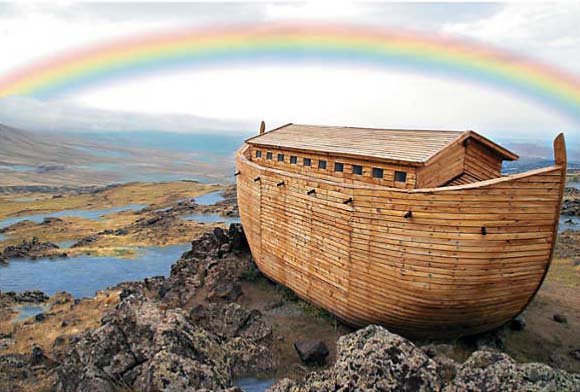
Must see video -  Defending Noah and the Worldwide Flood - Mike Riddle
Defending Noah and the Worldwide Flood - Mike Riddle
Mt. Ararat
The Bible says that around 4,400 years ago God sent a world-wide flood upon the earth and had a man named Noah build a large boat (Ark) to save his family and the animals. God gave Noah the exact dimensions of the Ark for two reasons: 1) Obviously Noah couldn't know how large it must be to hold all of the animals (no doubt small, young specimens), and importantly for us the second reason 2) So that future generations who found the Ark could verify the measurements so as to know it is one and the same boat.
Many people believe that Noah's Ark should be up on Mt. Ararat in Eastern Turkey, and many have looked there over the years because they think the Bible says its on that mountain. But does it really? Let's take a look at the Bible verse in question:
...the ark came to rest on the mountains of Ararat." Gen 8:4
Ararat is the newer Armenian name of Urartu from the Hebrew Torah written by Moses (c. 1406-1446 BC) which only included the consonants "rrt". However, the translators of the Bible replaced the "rrt" with the later name, "Ararat" or "Armenia." The Assyrians wrote about battles against the Urartian tribes from the thirteenth century BC until the sixth century BC when Urartu was destroyed by the Medes. The name Urartu then vanished from history (until archaeologists re-discovered it in the 1800s) and was replaced by Ararat and Armenia in the vicinity as well as in English Bible translations, maps, etc. As history went on in the first and second millennia AD, the mountain became known as Ararat and the region as Armenia. Many people believe that Mount Ararat is the place where Noah's Ark landed but the Bible does not state this. It simply says that the boat landed in the Urartian mountains, of which there are hundreds, although Ararat is the highest and is the only one with a permanent ice cap, which is around 17 square miles in size. Since Mount Ararat is the highest location in Urartu, some people in recent history have jumped to the conclusion that it was the landing place and promoted that concept as a regional tradition. It is quite possible that at the time of the Ark's landing, Mt. Ararat was still a baby volcano. So there is no special reason to think its on that mountain.
The Ark in History
In Flavius Josephus' time (1st-century A.D.) the Ark of Noah was well-known, because he mentions in Antiquities of the Jews. The famous Jewish historian stated, "Its remains are shown there by the inhabitants to this day." He quotes Berosus the Chaldean, c. 290 BC, who indicated tourists would take home pieces of the ark for making good-luck charms, "It is said there is still some part of this ship in Armenia, at the mountain of the Cordyaeans; and that some people carry off pieces of the bitumen, which they take away, and use chiefly as amulets for the averting of mischiefs." These comments tend to indicate its location would not be in an inaccessible area. At some point, the ark was covered by a mud and lava flow which caused future generations to lose its location.
1948 Discovery
Noah's Ark was discovered in mid May of 1948 by a local Kurdish shepherd boy named Reshit Sarihan, who lives to this day (Sep. 2000), in the village of üzengili (previously called "Nasar" but changed to üzengili after the ark was discovered. - One should take note that "Nisir" was the Babylonian name for Noah's city). Heavy rains in May of 1948, combined with three noteworthy earthquakes exposed the ark impression from the collapsing, expansive and loose mud that had entrapped it for nearly 2 thousand years revealing the ark impression standing up, out of the terrain.
Objects containing inked drawings and etchings pertaining to the Flood account have been found near the Durupinar formation (Shea, October 1998) and large inscriptions have been discovered on the structure itself (Patt, May 2001).
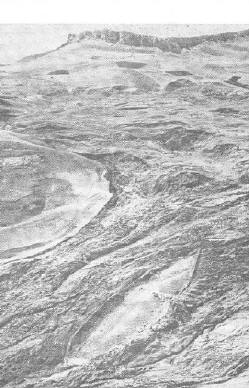
Aerial view is among the first ones taken eleven years after discovery, in 1959, and shows very little erosion, with hull shape intact.
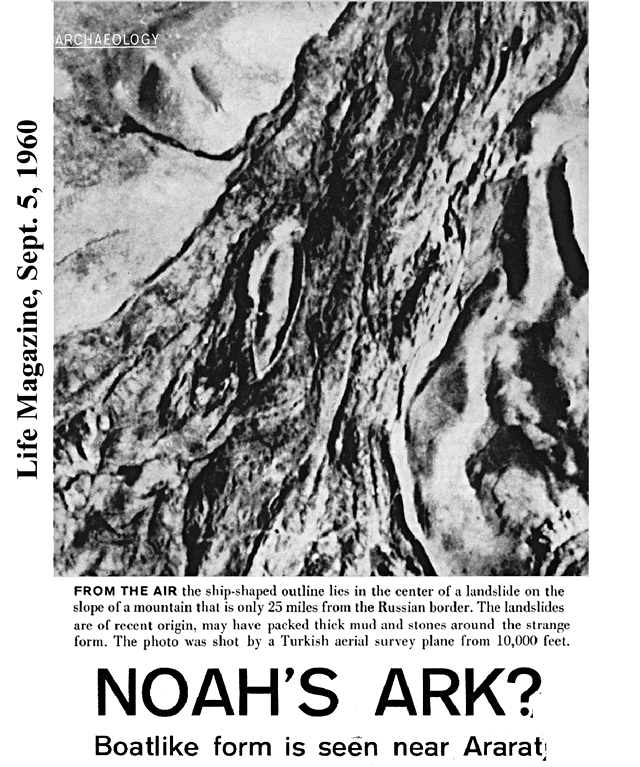
Noah's Ark Today
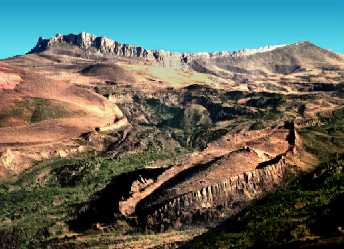
Courtesy of www.arkdiscovery.com
Noah's Ark Today
Durupinar Site
What would you expect a 5000 year old boat hulk to look like - one which was buried in mud for centuries? I would expect it to look pretty much like the photo above. Note that the Ark has slid down from higher above, as its in a mud flow. God has preserved the Ark under the mud and uncovered it only recently so it could be seen and researched.
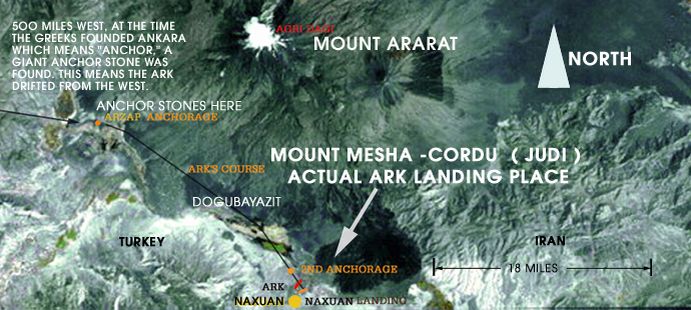
Courtesy of www.noahsark-naxuan.com
The photo at left shows the ark deeply embedded in the surrounding terrain, which is actually a mud flow. Mt. Cudi is shown high in the background, the initial landing place of the Ark. David Deal discovered a settlement above the site and another seeming-boat imprint there, which could be "The place of first descent" ('kHD' or Kurd) with the Durupinar site being the last one.
Ark Landing
Its believed the Ark actually landed higher up the mountain and has since slid down, probably more than once. Here we see an artist's rendition, based on the evidence, and the shape of the mountain, precisely how the ark would have landed on Mt. Cudi pronounced "Judi" (the "mountain of the Kurds" "kHuD" meaning, in Hebrew, "the first." The slightly crescent shape of the island (mountain) keeps the ark from being washed around by fast currents.
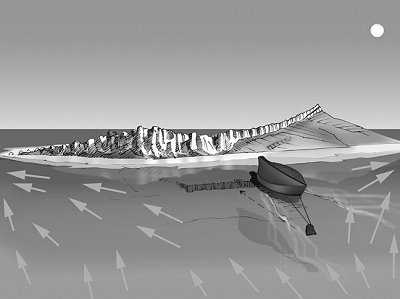
Courtesy of www.noahsark-naxuan.com
Notice the anchor stones hanging off the stern. These are known as "drogue stones" - 12 of which were actually discovered uphill from the location of the Ark (see actual photos below).
The photo at right shows the landing position of the Ark, and the path it took in its slide down the hill to its current location.
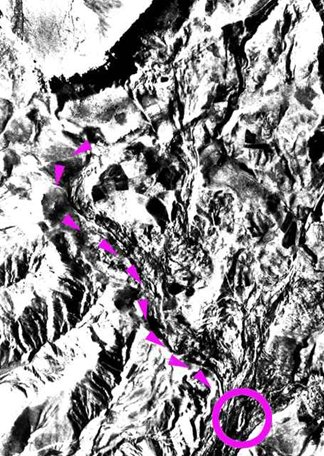
Courtesy of www.noahsark-naxuan.com
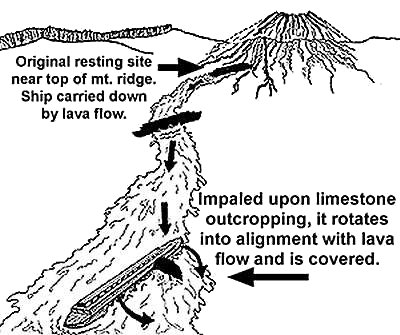
The Ark sits in a mud flow today. It originally came to rest higher on the mountain after the Flood. At some point in the first two thousand years of resting in the mountains of Ararat, the ark moved further down the mountain and became impaled on a rock outcropping where it rests today.
The ark rests on Cesnakidag Mountain, which is interpreted as "Doomsday" Mountain. The Flood would be considered a real "doomsday" since it destroyed the world. The mountain is made of sedimentary cretaceous water laid rock, which means it was formed by the Flood waters and is not a post Flood formation.
Ron Wyatt
In 1977, Mr. Ron Wyatt made his first of 24 trips to the ark, and he was impressed that this really was the remains of Noah's Ark. In the research he performed over the next 15 years, Mr. Wyatt successfully performed metal detection tests and subsurface radar scans of the site, and he proved this site really IS the mud-and-lava covered remains of Noah's Ark! The Turkish government hasdouble-verified Mr. Wyatt's tests, and they have given him credit for the discovery. The announcement appeared in Turkey's largest newspaper on June 21, 1987. The area was first designated a National Park, and then it was upgraded to the status of a National Treasure. The government has built a visitors' center overlooking the site and issued official tourist brochures so people of all races can come and see the ark! As the discoverer, Mr. Wyatt was invited to the official ceremony by the Turkish government.
Read the story of Ron Wyatt's Journey to find Noah's Ark
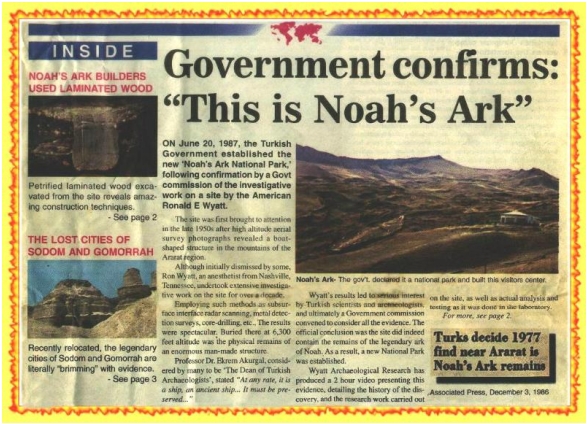
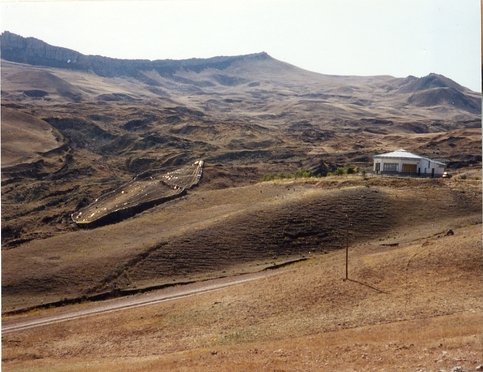
The Visitor's Centre overlooking the Ark
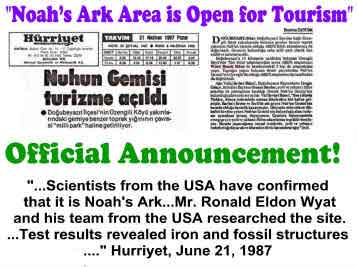
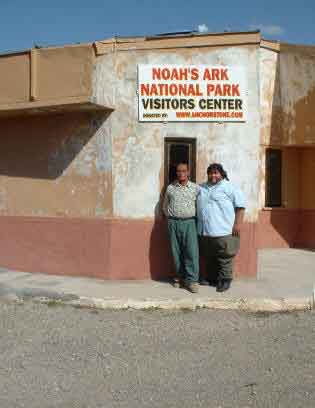
In 1978, when Mr. Wyatt was returning to Nashville, he prayed that God would send an earthquake to "excavate" the site. When arriving in Nashville the headlines read, "Earthquake in Eastern Turkey." The earth dropped from around the sides of the ark, defining the formation more clearly and making it more accessible for research.
Rib Timbers Clearly Visible
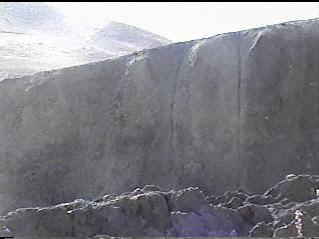
Courtesy of www.arkdiscovery.com
The western, starboard side of the ark boasts the most defined rib timbers, four of which are clearly visible above.
What would you expect a 4,500 year old boat hulk to look like? A boat that has been buried in a volcanic mud flow for the last 2,000 years? I don't know about you, but this is pretty much what I would expect.
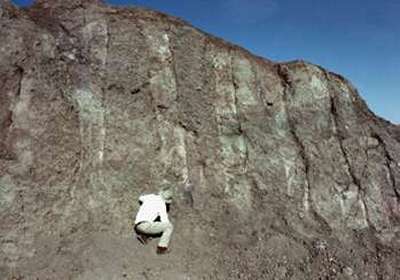
Courtesy of www.arkdiscovery.com
The port or eastern side of the ark, near the front, was scraped off by Ron in an effort to view the timbers without loose, crumbling material in the way. This process revealed the lighter color rib timbers in a systematic, vertical pattern. You can see a darker, curved pattern across the top, which represents the remnants of a large keelson.
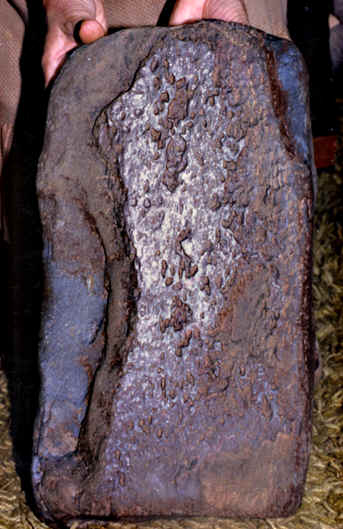
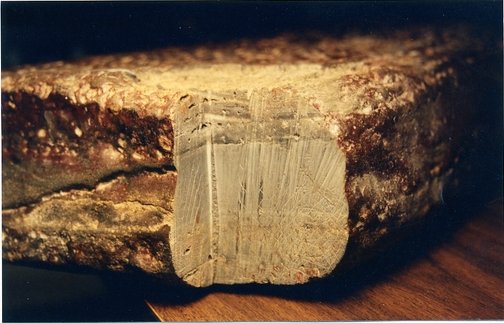
Petrified wood deck timber - note that there are no tree rings found in any of the timber samples.
This is as we would expect from the pre-flood world, where there were no seasons due to the
protective water canopy surrounding the earth.
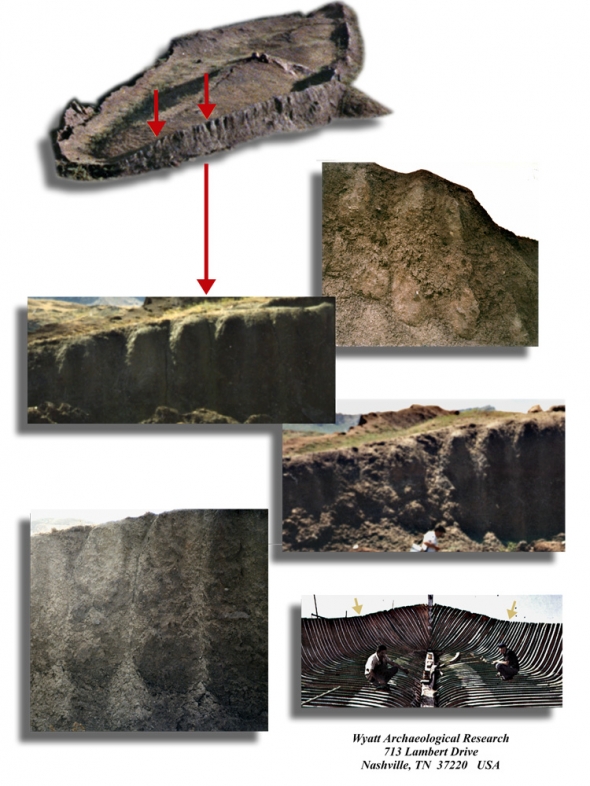
Deck Support Timbers
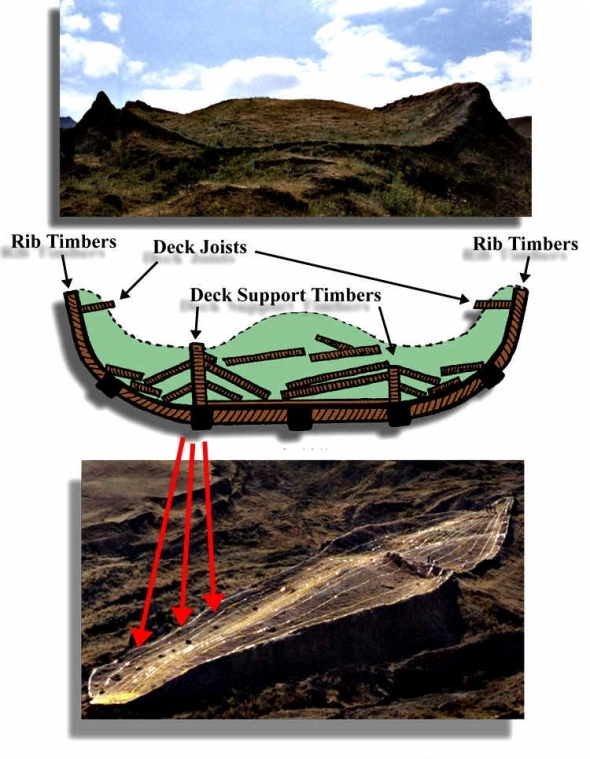
Many people want to pass this off as a "natural formation". But this structure is anything but natural. When reading other (negative) webpages about this find, bear in mind none of the detractors have actually been to the site. And they don't show any pictures of the Ark, as we do here. Why? Maybe because they don't want you to see it up close where you can see for yourself that its definitely not natural, but man-made? They also attack Ron Wyatt's integrity (of course!). When you want to discredit a discovery but you can't because it really is authentic, the next best thing is to discredit the discoverer! Ron Wyatt is a man of God and integrity. When you watch the videos, you will be able to discern this.
Now you may be wondering why a proper excavation hasn't begun on the site to prove to the world conclusively that this is or isn't Noah's Ark. We would all like to see this done. We can only speculate as to the reasons why, but the main reason is doubtless financial. The Ark rests in a mountain mud flow. To be able to excavate, a giant retaining wall must be built around the entire Ark site. This would no doubt cost in the millions of dollars. There may be political and religious reasons as well. Keep in mind that the Ark site is only a couple of miles from the Iranian border, which isn't exactly on friendly relations with the West, of which Turkey is actively trying to become a part of (joining the EU). We must understand that this part of the world is controlled by Satan for the very reason of denying access to these sites. And we see that it's certainly working!
Size of the Ark exactly as the Bible describes
God told Noah the exact size to make the Ark, obviously for two reasons: 1) Noah couldn't know how large it must be to hold all of the animals (no doubt younger, smaller specimens), and importantly for us the second reason 2) So that future generations who found the Ark could verify the measurements so as to know it is one and the same boat.
"Make a ship of gopher wood. You shall make rooms in the ship, and shall seal it inside and outside with pitch. This is how you shall make it. The length of the ship will be three hundred cubits, its breadth fifty cubits, and its height thirty cubits. You shall make a roof in the ship, and you shall finish it to a cubit upward. You shall set the door of the ship in its side. You shall make it with lower, second, and third levels." --Gen 6:14-16
The length of the ark hulk is 515 ft., which is exactly 300 Egyptian cubits (20.6 inches). The sides have splayed outwards, as we would expect on a 4,500 year old boat hulk. Moses was schooled in Egypt and was not familiar with the Hebrew cubit which was not even in existence when Moses wrote Genesis. So the length is exactly matches the Bible! Of course, this is just what we should expect. The Bible is all true!
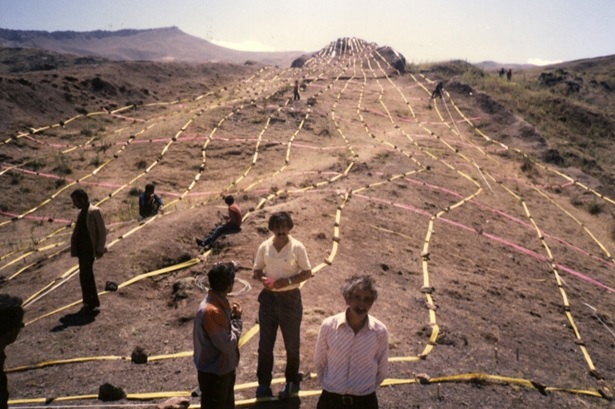
Sub-surface Radar scans show a regular pattern of timbers inside the ark formation, revealing keels, keelsons, gunnels, bulkheads, animal chambers, ramp system, door in right front, two large barrels in the front 14' x 24', and an open center area for air flow to all three levels.
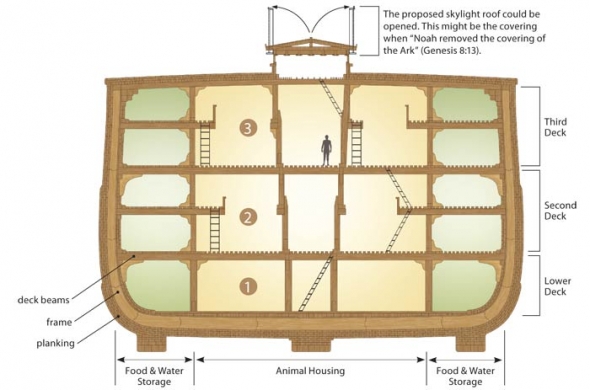
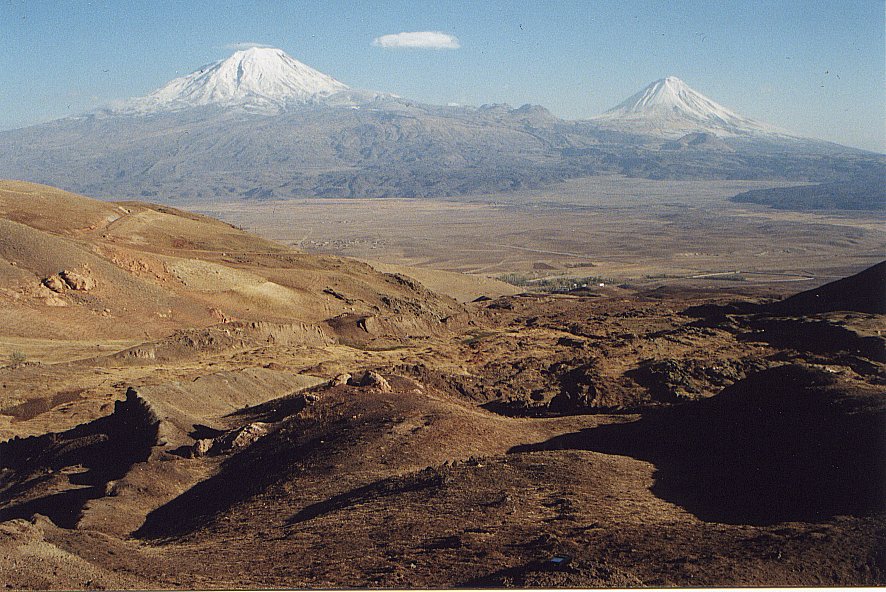
Looking down from the top end of the Ark at Mt. Ararat and Little Ararat
12 Giant Stone Anchors Found Uphill
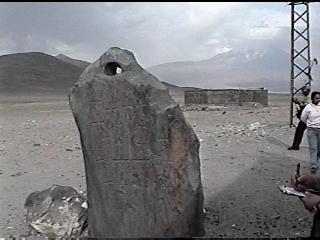
Courtesy of http://www.arkdiscovery.com
12 Drogue Stones like this one were discovered uphill by Ron Wyatt in 1977. Some have 8 crosses and other depictions of the 8 people who were on the Ark.
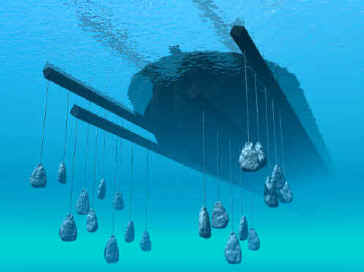
Courtesy of www.arkdiscovery.com
This shows how Drogue Stones were used on ancient ships.
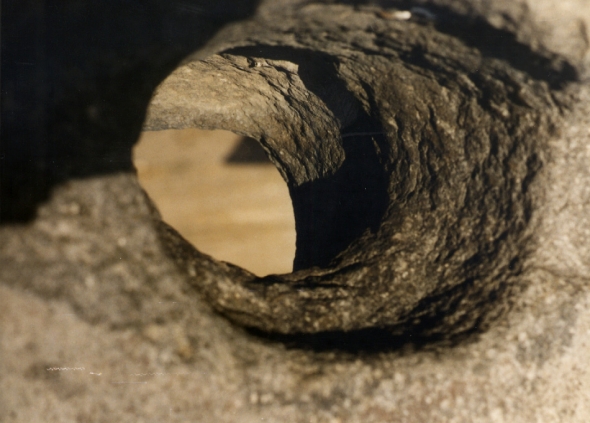
Drogue stones were a feature of ancient ships, and were the ancient equivalent of a storm anchor. They have been found in the Nile and elsewhere in the Mediterranean area, and like the stones found by Wyatt, they are heavy and flat with a hole for connecting a line at one end. Their purpose was to create drag in the water or along shallow sandy bottoms: the stone was attached to one end of a boat, and the drag produced would cause the bow or stern to face into the wind and the oncoming wind-blown waves. These anchor stones are found near the Ark site (a few kilometres), no doubt cut loose by Noah as he approached land.
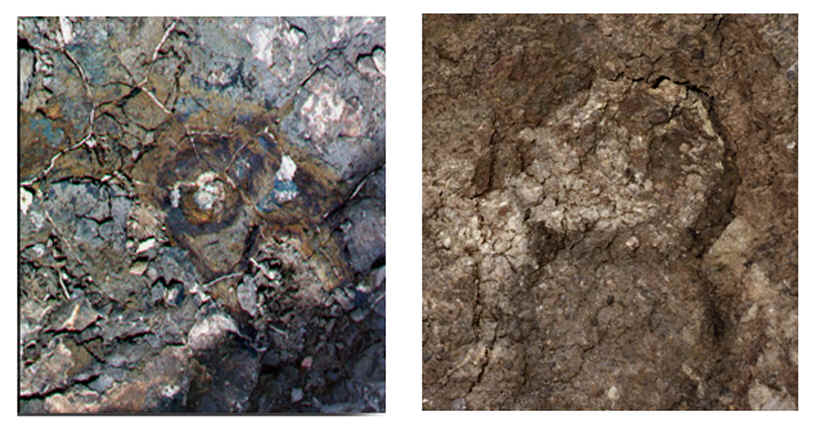
Courtesy of http://www.ronwyatt.com
Iron Brackets with rivets and hot struck indented pins all over the formation.

Courtesy of www.arkdiscovery.com
Best example of many metalic rivets found. Contains high-tech metal alloy, as proven by separate lab analyses paid for by Ron Wyatt, then performed later by Kevin Fisher. Aluminum metal and titanium metal was found in the fittings which are MAN-MADE metals!
Read Galbraith Lab Report on Metal Rivets

Courtesy of www.arkdiscovery.com
Petrified coral found at 6500 feet in elevation at the formation with a smooth flat backside that shows that it was attached to an object that was not natural.
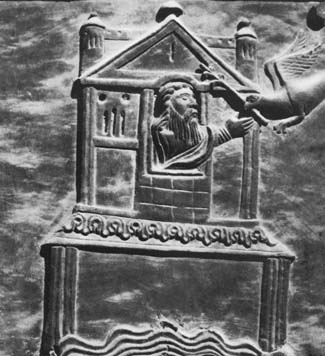
Ancient tablet testifying to Noah's Flood
See Noah's Ark on Google Earth Today
Google Earth Link
39°26'25.25"N
44°14'4.09"E
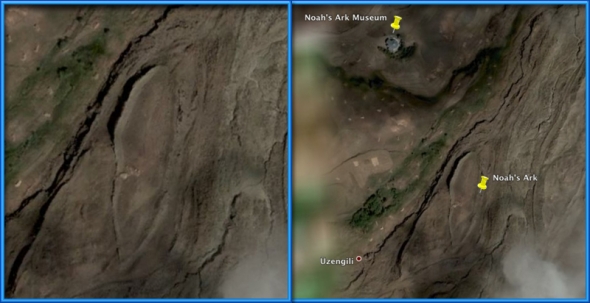
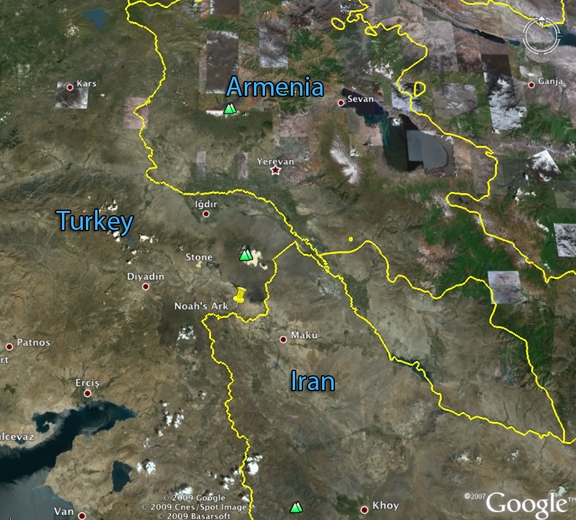
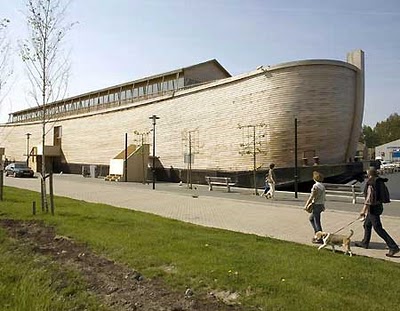
A half-sized replica of the biblical Noah's Ark has been built by a Dutchman,
complete with model animals. Dutch creationist Johan Huibers built the
Ark as testament to his literal belief in the Bible. Also to be used in the
promotional campaign for Evan Almighty.
Watch the Video 
35 minute video from 4 hour DVD, Revealing God's Treasure
Read the story of Ron Wyatt's Journey to find Noah's Ark
|
The Real Noah's Ark!
|
The following are two chapters from "Old Earth, why not?" by James I. Nienhuis (genesisveracity.com). You can read the entire document by clicking here.
Is Noah’s Flood just a Fairytale?
Hundreds of tribal groups are spread all over the globe. Their oral traditions and legends have been passed down from their ancestors through the generations. One legend is very common among the tribes, like this one from New Guinea:
“Once a great flood came which covered the whole earth and wiped out everyone on earth except for the ancestors of the Biami people. Those ancestors climbed up into the Gobia Tree, the bark of which they make into string for their string bags. They took up into the tree their planting materials for crops, all their animals, their dogs and their pigs and every30 thing else necessary for life. As the floodwaters rose up on the face of the earth the people climbed further up the tree. They were safe in the branches of this tree because the tree grew up above the waters as the waters rose up. When the waters went down from the surface of the whole earth, the people were able to climb down the tree. The ground was very muddy, but eventually they planted their crops and their animals began to reproduce. They moved away from the tree and began to repopulate the earth. Those who had climbed down out of the tree were the ancestors of the Samos, the Kubos, the Gobasis, and the Etoro.”
One ancient classic Chinese writing, called the Hikking, tells the story of Fuhi, whom the Chinese consider to be the father of their civilization. This history records that Fuhi, his wife, three sons and three daughters, escaped a great flood. He and his family were the only people left alive on earth. After the great flood they repopulated the world. An ancient temple in China has a wall painting that shows Fuhi’s vessel in the raging flood waters. Dolphins are swimming around the boat and a dove with an olive branch in its beak is flying towards it.
Over 270 tribes have been documented to be proponents of the notion that the whole world was once inundated by water. Here is one from the Greenlander tribe of Canada:
“The world once overturned. Some people were turned into fiery spirits, all the rest drowned but one. Afterwards, the survivor smote the ground with his stick, a woman sprung out, and the two of them repopulated the world. Proof of the flood is found in the form of sea fossils on high mountains.”
(Fossils of ocean creatures in the mountains will be explained in Chapter 9.) The details of the basic flood theme vary from tribe to tribe, but obviously, this story was passed down from ancestors who were knowledgeable of the same cataclysmic event, a flood of water unparalleled in human history. The ancient Assyrians knew of this flood:
“The gods, led by Enlil, agreed to cleanse the earth of an overpopulated humanity, but Utnapishtim was warned by the god Ea in a dream. He and some craftsmen built a large boat (one acre in area, seven decks) in a week. He then loaded it with his family, the craftsmen, and ‘the seed of all living creatures’. The waters of the abyss rose up, and it stormed for six days. Even the gods were frightened by the flood’s fury. Upon seeing all the people killed, the gods repented and wept. The waters covered everything but the top of the mountain Nisur, where the boat landed. Seven days later, Utnapishtim released a dove, but it returned finding nowhere else to land. He next returned a sparrow, which also returned, and then a raven, which did not return. Thus he knew the waters had receded enough for the people to emerge. Utnapishtim made a sacrifice to the gods.”
No other legend pervades the lore of the world’s tribes as does the Great Flood. In Africa, the Pygmies (Central Africa), the Kikuyu (Kenya), the Yoruba (southwest Nigeria), the Mandingo (Ivory Coast) and the Kwaya (near Lake Victoria), among others, have ancestral knowledge of the Great Flood. In North America, the Eskimos and the Innuit (Alaska), the Yakima (Washington state), the Chippewa (Great Lakes), and the Choctaw (southeast U.S.), among others, have generational awareness of a global flood.
In Asia, the Kamchadale (Siberia), the Bahnar (Cochin China) and the Miatso (southern China), the Chingpa (Burma), and the Andaman (Bay of Bengal), among others, know by oral tradition of a cataclysmic flood event. In Europe; the early Greeks, Germans, Celtics, Vikings, and Welsh, among others, noted the Flood in their lore. In Central and South America, the Yaqui (northern Mexico), the Nahua (central Mexico), the Maya (Guatemala), the Ipurina (upper Amazon), and the Coroado (southern Brazil), among others, speak of a worldwide deluge in their ancient histories.
In the Pacific Islands and Australia, the Kabadi (New Guinea), the Maori (New Zealand), the Mangaia (Cook Islands), the Gumaidj (northern Australia), and the Polynesian Hawaiians, among others, know the Big Flood. In the Middle East, the Zoroastrians (Iran), the Egyptians, the ancient Babylonians (Iraq), the ancient Hittites (Turkey), and the Hebrews (Israel), among others, have recollections of an historical catastrophic deluge.
The Hebrew report in the Bible (Genesis 6,7,8) of this world famous Great Flood is the most well known account: God was displeased with mankind, so He flooded the earth, killing all that were not on Noah’s Ark. The waters flooded the earth for 150 days, then began to recede. The Ark landed in the Mountains of Ararat (Eastern Turkey), then, Noah sent out a raven that did not return. He then sent out a dove that returned with an olive twig. The next week he sent the dove out again it didn’t return, so Noah figured it was to time disembark from the Ark.
The Michoacan tribe of Mexico has a similar flood legend:
“When the floodwaters began to rise, a man
named Tezpi entered into a great vessel, taking
with him his wife and children and diverse seeds
and animals. When the waters abated, the man
sent out a vulture, but the bird found plenty of
corpses to eat and didn’t return. Other birds
also flew away and didn’t return. Finally, he
sent out a hummingbird, which returned with
a green bough in its beak.”
To perceive the Biblical Flood story as fantasy is to call the ancestors of these tribes liars. The politically correct mainstream scientist has a real dilemma here. It seems extremely unlikely that disparate people groups from around the globe, with no interest in copying each other’s heritages, would have similar legends of global destruction by water, unless of course, these tribes are actually recounting an historical event. Evidently, there is more to this Flood thing than most people realize.
Please visit these other sites for more photographs and other evidences proving this really is Noah's Ark
wyattmuseum.com
Last updated: 21st December 2015 by http://www.6000years.org/frame.php?page=noahs_ark
www.ronwyatt.com
www.biblediscoveries.com
www.noahsark-naxuan.com
www.biblediscoveries.com
www.arkdiscovery.com/noah's_ark.htm
avdil.gtri.gatech.edu/RCM/RCM/5RCMArkeology/6Durupinar.html



